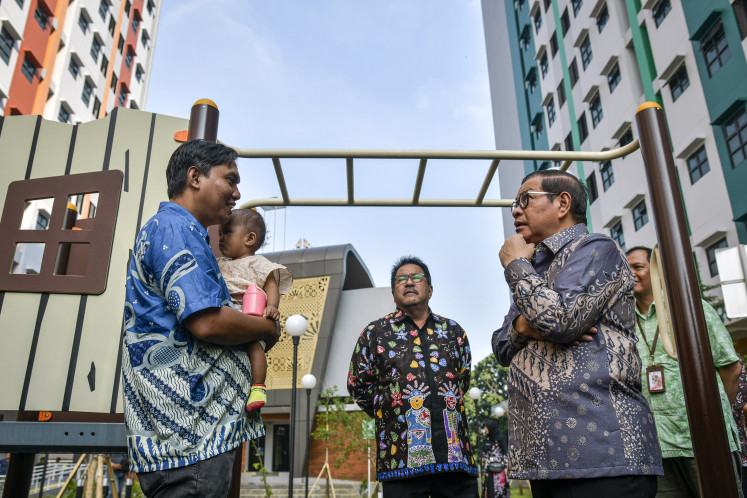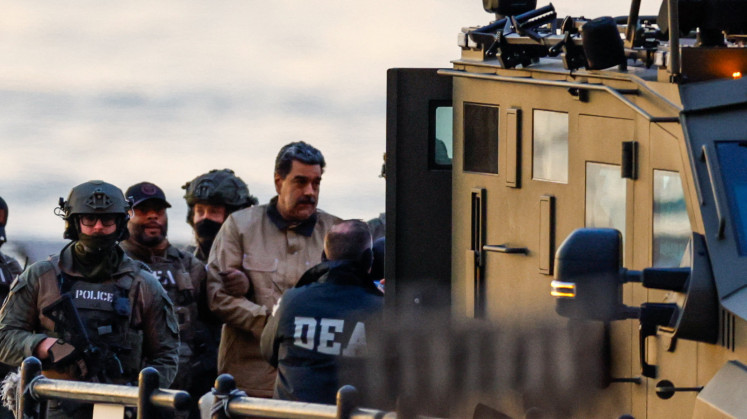Popular Reads
Top Results
Can't find what you're looking for?
View all search resultsPopular Reads
Top Results
Can't find what you're looking for?
View all search resultsFrom weapons procurement to defense investment
The defense industry will be one of the key drivers of the manufacturing sector, whose contribution to GDP continues to decrease.
Change text size
Gift Premium Articles
to Anyone
S
ince his appointment, Defense Minister Prabowo Subianto has considered the modernization of the Indonesian Military (TNI) as one of the main objectives of his mandate. While the ongoing modernization attempt, known as the Minimum Essential Force (MEF) plan, has been considerably delayed, such policy is welcomed by end-users and defense experts.
It is worth noting that on the TNI's anniversary on Oct. 5, President Joko “Jokowi” Widodo relayed two important messages related to the modernization strategy of the TNI. First, which has been widely welcomed by observers, was to encourage the defense minister to acquire only the best weapon systems. Second, which has an important meaning for the country, is the President’s emphasis on the need for investments in the defense sector. Jokowi said Indonesia must shift from defense equipment procurement to defense investment with long-term planning and implementation.
As a matter of fact, the President’s statement should lead to a legal framework, such as Law No.16/2012 on the defense industry, which provides a path and a legal basis for Indonesia to invest in its defense modernization program. The legislation makes it mandatory for foreign original equipment manufacturers (OEMs) to provide additional economic benefits to Indonesia through countertrade, local content and offset (CTLCO) obligations.
Earlier this year, the Defense Ministry explained that the objective of offset programs was to support the development of Indonesia’s defense companies, including to enhance cooperation between domestic companies and foreign suppliers. The cooperation will be directed toward CTLCOs to help local firms in order to achieve a major objective: “self-sufficiency” for Indonesia in terms of defense equipment procurements, which will lead to less dependence on foreign suppliers.
To a greater extent, the policy also aims to increase Indonesian defense companies’ contributions to the country’s gross domestic product (GDP). As National Development Planning Minister Suharso Monoarfa said in September last year, the defense industry will be one of the key drivers of boosting the manufacturing sector, whose contribution to GDP continues to decrease. Nonetheless, until today, the implementation of the 2012 law to bring investment through the defense modernization program has not been very significant.
While defense equipment is costly, it also represents a great chance for Indonesia to maximize the economic advantage of procurement programs, including developing and strengthening its Defense Technological and Industrial Base (DTIB). Although the implications are different for each country, it is essential to highlight that whether defense spending brings positive or negative impacts depends on the chosen offset and transfer of technology (ToT) programs.
Research suggests that in general, defense industrialization in Indonesia has had positive impacts on the country’s economic growth while allowing Jakarta to master new technologies.
In the draft 2022 state budget, the Defense Ministry was granted US$9.3 billion, which will be used for its defense equipment modernization program ($3 billion) and military personnel expenses and welfare ($840 million).
In parallel, President Jokowi recently signed Presidential Regulation No. 85/2021 on the 2022 government work plan (RKP), which targets the achievements of the MEF to reach 85 percent by 2022, supported by a $2.06 billion budget for defense equipment procurement and industry. Meanwhile, the Finance Ministry has also granted determination of source of funds (PSP) amounting to $5.8 billion for defense procurement for 2021. Theoretically, the higher the military spending, the bigger the number of investment opportunities for Indonesia.
Investment in the defense sector could take several forms, including but not limited to investment in infrastructure, research and development, project development and ToT, among other methods. For instance, major weapon systems procurement deals, such as for submarines, will not only strengthen the TNI's maritime defense posture but also create hundreds to thousands of job opportunities for ToT recipients.
Taking an example from Brazil and India, submarines procurement programs have led to the creation of millions of dollars’ worth of work packages for local industries, representing millions of hours of work, and respectively, more than 15,000 and 12,000 direct and indirect jobs. It is also important to note that both countries have also received investments to produce submarines’ components and even full submarines on their own.
In other words, defense ToT is definitely contributing to economic growth, and its value should be considered during the decision-making process.
It is worth keeping in mind that for years, Indonesia has focused on off-the-shelf procurement, which provided little to no value to the domestic DTIB. With a potential increase in budget for defense equipment spending, offset – both direct and indirect – and more importantly, ToT, have undoubtedly had a significant impact on economic growth. And this is even more important in the current situation, as domestic DTIB – and more particularly defense state-owned enterprises, such as aircraftmaker PT DI, shipbuilder PT PAL, communications equipment manufacturer PT LEN and weapons producer PT Pindad – have also been deeply impacted by the COVID-19 pandemic.
In this perspective, defense equipment procurement should be carefully assessed and when possible, directed to maximize investment opportunities through ToT and offset, which will eventually increase the local defense industry's capabilities and eventually contribute to the national economic recovery and growth.
Furthermore, offset programs in defense procurement should not only be used for human capital development through education and training but also to boost productivity, and create jobs and working hours, which can eventually revitalize domestic firms. Notwithstanding the questions of whether local companies are mature enough in receiving and/or implementing offset or not, the benefit of such programs outweighs the concerns.
Defense investment through offset and ToT programs should actually be the main consideration behind weapons systems procurement negotiations. With Prabowo’s long-term modernization plan and Indonesia’s goal of being a developed country by 2045, defense investment opportunities will not only benefit the end-users but also increase the domestic defense industry’s contribution to the country’s GDP.
In the end, the best weapons systems should not only be based on their capacities and capabilities for the end-users but also on what they bring to the whole defense ecosystem.
***
Anastasia Febiola S. is a research analyst on defense matters at Semar Sentinel PTE Ltd, where Alban Sciascia is the director. The views expressed are her own.










